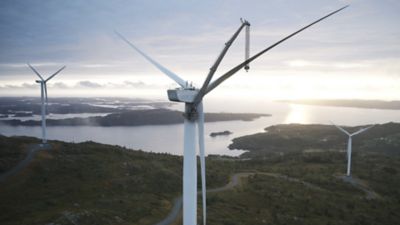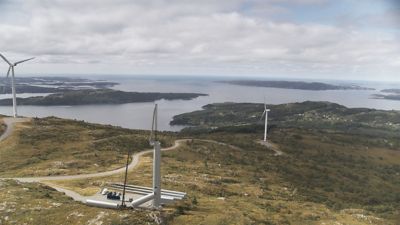-
-
Access Free Student Software
Ansys empowers the next generation of engineers
Students get free access to world-class simulation software.
-
Connect with Ansys Now!
Design your future
Connect with Ansys to explore how simulation can power your next breakthrough.
Countries & Regions
Free Trials
Products & Services
Learn
About
Back
Products & Services
Back
Learn
Ansys empowers the next generation of engineers
Students get free access to world-class simulation software.
Back
About
Design your future
Connect with Ansys to explore how simulation can power your next breakthrough.
Free Trials
ANSYS BLOG
March 2, 2022
A Climbing Crane Helps Energy Harvesting Reach New Heights
If you’ve ever driven past a wind turbine farm in the distance, you know the sight of these giant pinwheels spinning in the wind is awe-inspiring. But if you’ve stood at the base of one of the taller turbines and looked up, you also know the scale is difficult to fathom. Perched on top of a wind turbine tower are multiple, gigantic components collectively weighing several hundred tons. Given their size and scale, it’s easy to imagine the challenges of assembling these huge structures. Inspired to address the risks, complexities, and costs of wind technology, Liftra is creating a climbing crane that can safely and efficiently build wind turbine towers from the ground up. The company, which designs, produces, and operates custom lifting and transport solutions for the global wind turbine industry, was able to break down design barriers thanks to simulation and cloud computing.

LT1500 Concept view from the top of the turbine
Wind Turbines Present Massive Installation Challenges
Construction on a supersized scale brings with it some major logistical and safety challenges. Moving components from the factory to the wind farm site involves handling enormous parts weighing several tons. It also requires equally large trucks to transport them between sites. Guiding these heavy parts up in the air during installation has traditionally required enormous mobile cranes transported by the truckload. Plus, dealing with the sheer size of these components during the assembly process involves numerous high-risk activities working at high altitudes while handling big equipment and executing complicated lifts.
For workers, there's always a risk of struck-bys (getting hit by a component on the job) or injury from falling parts. At the top of the wind turbine, every component must be bolted on. With the help of a crane, workers must carefully lift and guide parts. If they lose their connection to a part during the process and it is dropped, it has the potential to hit people standing at great distances from the tower. That is precisely why a large amount of ground around the wind turbine is cleared, just in case.
A Wind Turbine Construction Solution
Liftra recently addressed these challenges and revolutionized the installation of wind turbines in the process. They are developing the LT1500 crane that “climbs” the wind turbine tower as it is being assembled, instead of sitting beside it. Once mounted to the base of the wind turbine tower, the bottom of the crane grabs onto a flange of one tower section and lifts the next section into place. Then, a hoist block is lifted up and attaches to the higher section where it pulls the crane up the tower to attach to the higher flange. In a sequence of such grabbing and hoisting moves, an entire wind turbine, including the tower, nacelle, rotor, and blades, can be constructed.

LT1500 Concept begins tower assembly
The benefits of the LT1500 design are numerous, from reducing equipment, energy, and transport costs, to improving the safety of work crews. Using a standard crane that’s big enough to build a wind turbine 393 feet or higher takes between 40 and 50 loads for transport and requires longer assembly times at greater heights. Unlike a standard crane, the LT1500 is compact enough to be transported by eight trucks between sites and assembled on the ground, cutting assembly time while substantially reducing the overall site footprint.
For this unique application to work, the crane-to-tower interface had to be exceptionally strong. Failure was defined by the integrity of the welded flanges (or connecting parts of the wind turbine tower) where the crane attaches. Without taking these load-bearing characteristics into consideration, mounting the crane to the turbine tower could cause bending in the welded flanges and risk damage to the tower. To properly assess these load-bearing characteristics, Liftra engineers established four contact points along the tower. Using Ansys Mechanical, they tested the stress distribution and loads distribution between all four points to ensure the load was equally distributed among them.
Running finite element structural simulations both in Ansys Cloud and on their own workstations, the engineering team at Liftra performed static simulations of the loads involved when the crane is attached to and climbs up the wind turbine tower. Both linear and non-linear material models for elastic/plastic analysis were run in Ansys Cloud on a Microsoft Azure HC series virtual machine featuring 44 Intel Xeon Platinum 8168 processor cores to determine the possibility and extent of any permanent deformation to the tower. The models included 1.8 million nodes with many nonlinear contacts (more than 100 frictional contacts).
5X Faster Analysis with Ansys Cloud
Working with Ansys Cloud meant that Liftra engineers did not have to divide their analysis into multiple simulations. They could instead set up and run models as a single simulation resulting in more accurate calculations. To this end, using Ansys Cloud also resulted in a considerable time savings — the simulation was completed in 1 hour versus 5 hours on company workstations. Ultimately, through a series of finite element simulations, Liftra engineers confirmed that the LT1500 crane would not cause any deformation of the wind turbine tower as it climbed.
“Of course, being able to set up these large models in Ansys Cloud makes for a better and safer design,” says Miguel Adolfo Hoffmann, senior engineer specialist at Liftra. “You will capture things you may not be able to see in a smaller model. Instead of splitting the analysis up and calculating the interface forces, we are now able to do everything in the same analysis with greater confidence in our results.”
Hoffmann says Liftra has been using the software to solve various engineering challenges from the start.
“I think one of the main advantages of using Ansys products is that they are a well-known brand,” he says. “Meeting industry regulations to build a safer wind turbine installation solution involves presenting our calculations for third-party review to certify they are within acceptable limits. Ansys calculations make it easier to get things approved. Everyone knows Ansys and assumes that their results can be trusted.”

Reimagining wind farm construction with the TL1500 Concept
Learn more about how Ansys helped Liftra bring their LT1500 crane concept to life. Want to know more about how Liftra is successful with Ansys and its partners? Register for a free live webinar that takes place March 29, 2022.